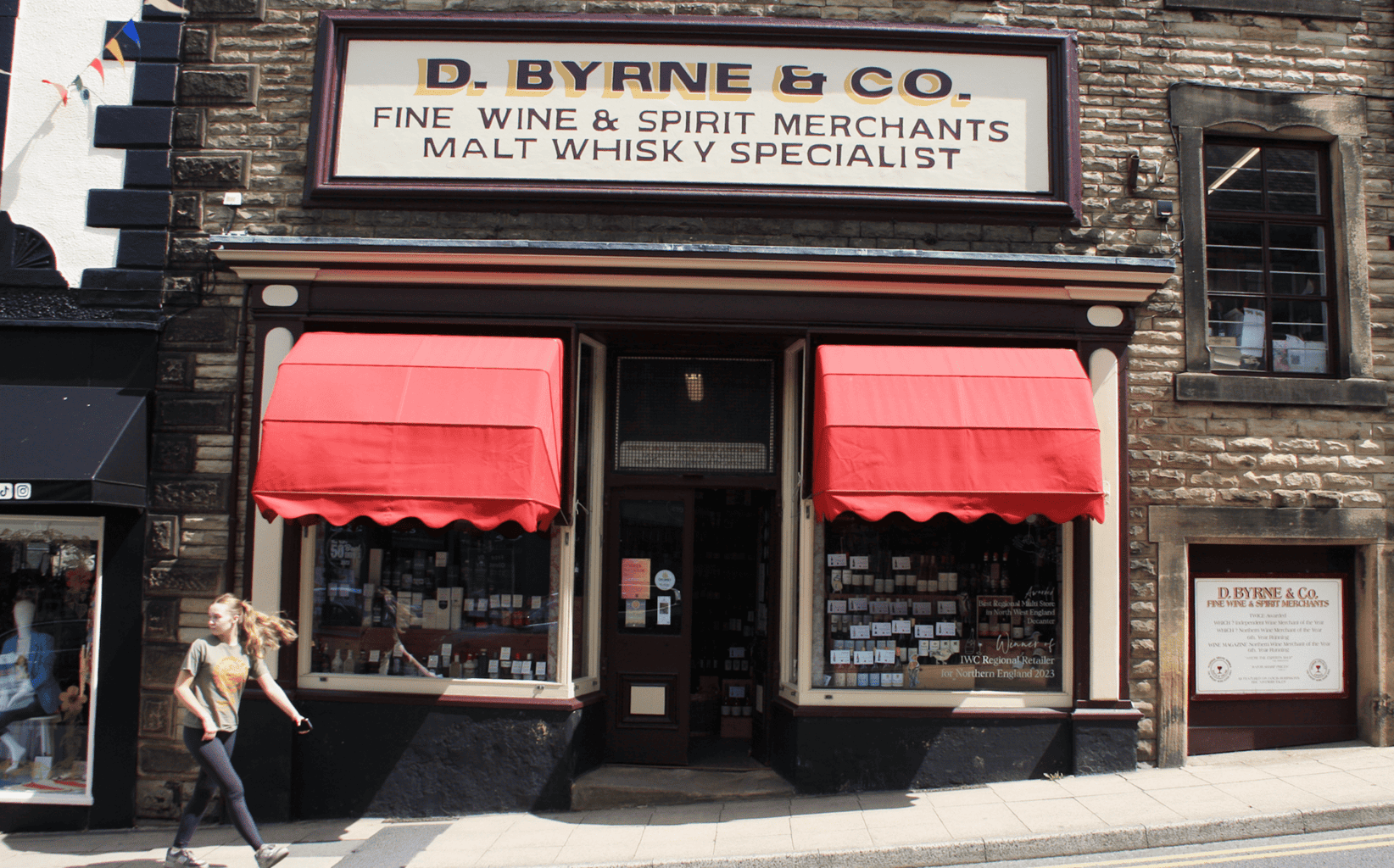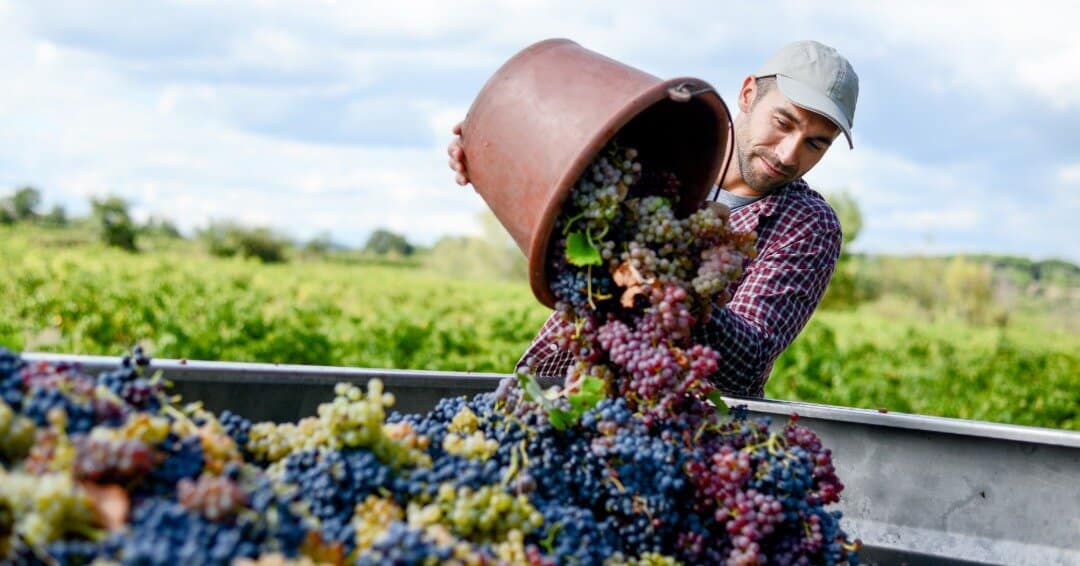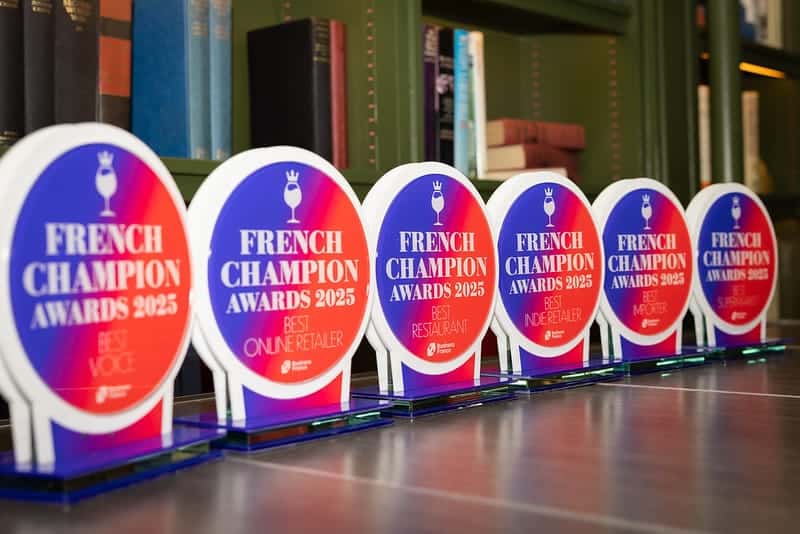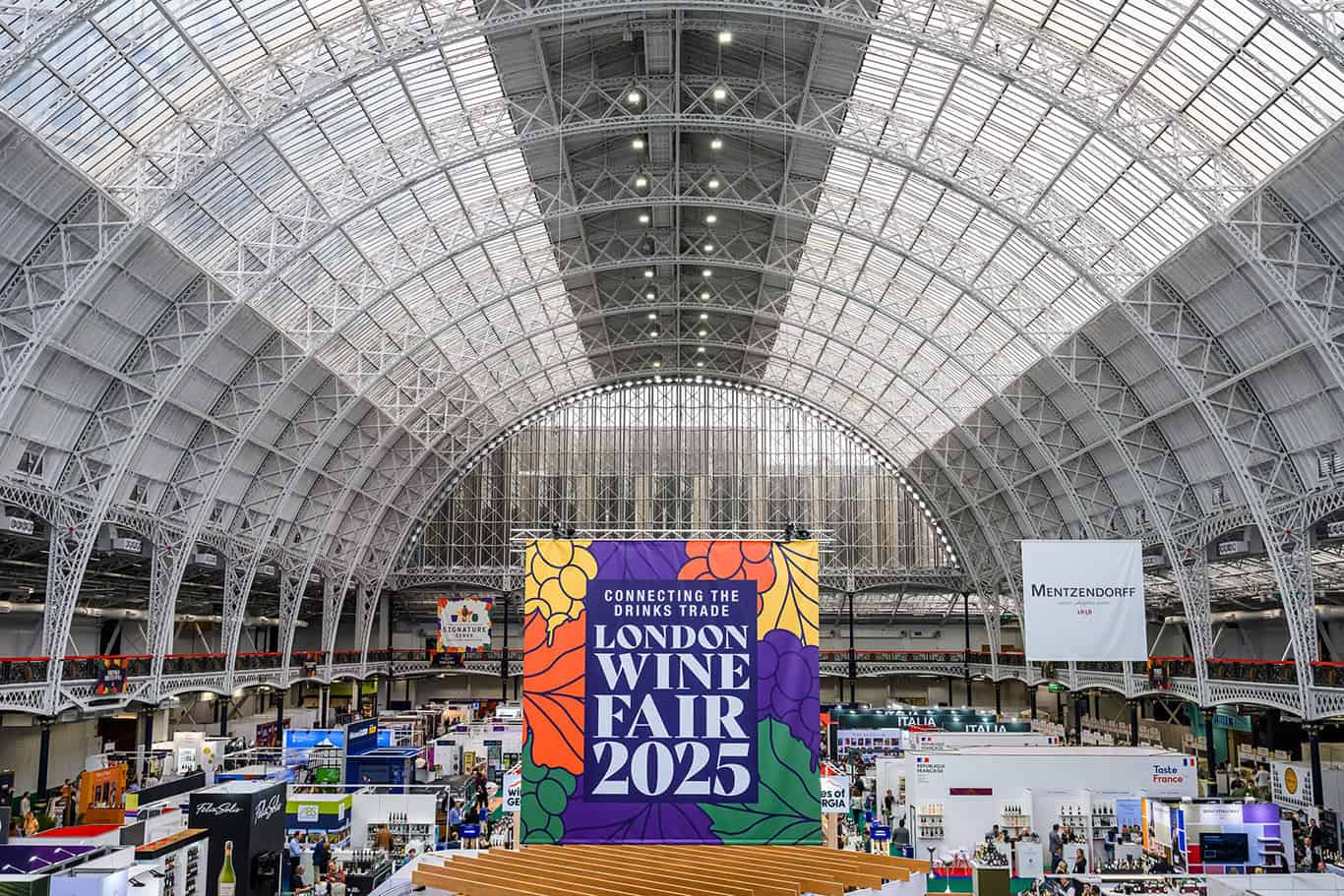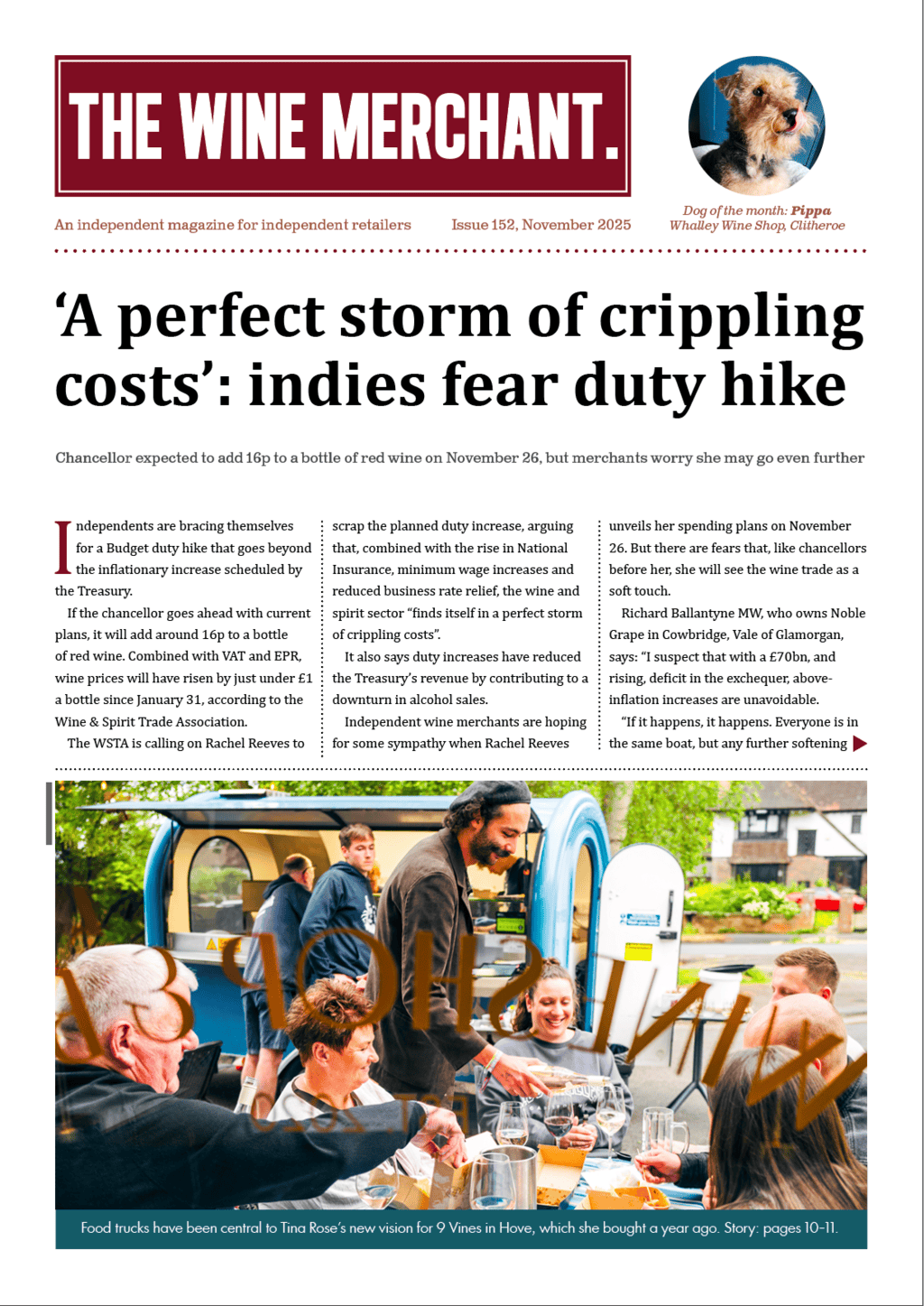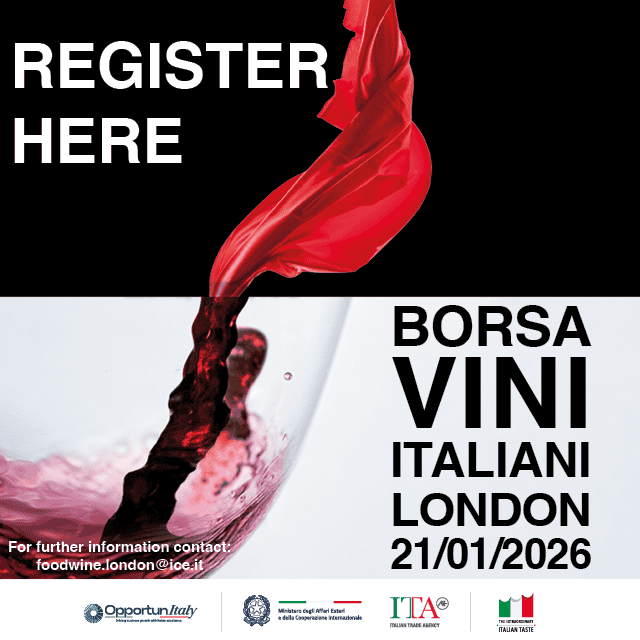Since being immortalised in Jancis Robinson’s Vintners’ Tales series on BBC2, D Byrne & Co has taken its place at the top table of the independent wine trade. It almost became a legal requirement to refer to its Victorian premises as an “Aladdin’s cave”. But Covid restrictions saw this beloved space closed, with the sales operation switching to a less romantic warehouse. Today, both sites are open, and thriving, as Nigel Huddleston discovers
The pandemic hit independents in different ways but it’s doubtful many experienced more major disruption to the status quo than D Byrne.
The Lancashire business had been operating out of the same shop in King Street in the centre of Clitheroe since 1879. The hilly site comprises a tiny room off the street with a 12-foot high ceiling and a cellar that burrows its way under the property next door – far from suitable for trading under social distancing rules.
The solution was to turn the nearby former Victoria Brewery that the company already used for storage into a retail space instead. What was intended as a temporary measure has now become a second permanent home for D Byrne, such was its success.
At around the same time, the family business transitioned to a new generation, brothers and Andrew and Philip taking back seats and handing the day-to-day reins to cousins Joe, Andrew’s son, and Kate, Philip’s daughter.
“I left school at 16,” says Joe. “My mother wanted me to go on to further education and, to be honest, when I left school there wasn’t a position available in the shop. But within a week someone left, so I left college and never looked back. I’ve had a part-time job here since I was 11 and a permanent one from 16 onwards.”
Joe looks after the warehouse – a mere five-minute walk from the original store, which is Kate’s domain.
“It was different for me,” says Kate. “I went to university in Manchester and did a degree in illustration and design and brought that into the business. I do any illustrations we need and a quarterly newsletter in full.”
She’s also poured her creative side into a food and wine paring wall that suggests matches for different types of meat or fish, or national cuisines.
“It’s quite fun and allows us a bit of creativity,” she adds. “The Ribble Valley is getting a bit of a reputation for food and we’ve got some really good eateries with Michelin stars, so it’s slightly tapping into that, but comes from someone who loves to cook.
“It’s a fun way to be able to display because you’re not confined to having to do it by country or grape variety. It means people are hopefully likely to pick up something they wouldn’t normally try.”
Byrne’s shift to becoming a wine merchant is relatively recent history, says Joe. “The shop was started by our great great grandfather, initially as a grocer that sold wine and spirits,” he explains. “In the late seventies we started increasing the range of wines and spirits.
“We still do things like loose tobacco and coffee, so we’ve kept our hands in a little bit as grocers but it’s predominantly wines and spirits.”
Kate adds: “We’re pretty old-fashioned in that we don’t work on bar codes, there are no scanners, so it’s all done from memory. Whether that’s the right way I don’t know but it does allow us a massive amount of flexibility.
“We can buy a case of this and a case of that and see if it works, and if it doesn’t, we can drop it, and then we don’t have the knock-on effect of having to remove it from the system.”
The contrast between the two sites couldn’t be more pronounced, with wines at the warehouse split between a vast loading bay-type area and another room that’s merely a little less big. The counter is in a smaller (but still not that small) room to the front, which is mostly home to spirits. A 19th century price list on display there includes “Prussian sherry” at 15 shillings a dozen.
Up at King Street, another display case features a flyer for Jancis Robinson’s Vintners’ Tales series for BBC2 from the 1990s, which helped elevate D Byrne’s reputation in the trade. The business was the focus of its own episode in a series that also featured the likes of Michael Broadbent, John Avery and Corney & Barrow.
“That was the thing that really pushed us forward and really opened us up to a more nationwide customer base,” says Joe. “Touch wood, it’s continued ever since.”
The Q&A took place with Joe at the warehouse site.
How did the switch from King Street to the Victoria Brewery come about?
The cellars at the shop are fantastic but with the rules in place, and the ventilation, it would be have been one in, one out with a maximum of three people. So we made the decision quickly that if we were going to continue to trade it would have to be at the brewery, which we were already using as a warehouse for wholesale and to supply the shop.
Parking’s such a huge benefit. We always thought we might do something with it but, one, we never really found the time, and two, we never really had a clear idea of what to do. When our hand was forced, it really worked well.
It’s a huge space but doesn’t feel empty. Have you had to increase your stockholding to fill it?
Slightly. But really it’s just made us able to get more of what we had already on display. A lot of this was here but wasn’t visible because we didn’t have the shelf space for it at the shop. Here there’s practically endless space to fill. We keep adding on regions.
What made you decide to make it permanent and do both?
The warehouse had worked so well. King Street has lots of nooks and crannies and things were hidden away a bit. Here it’s all very easily visible. Initially we did a trial run of opening King Street back up, just with the front part of the shop, just to work out whether both sites would run alongside each other. Then it was like, it’s working, so at Easter of last year we reopened the cellars. They’re a little bit stripped back from how they were, a bit cleaner, a bit fresher. Kate’s done the big food and wine pairing wall which works really well – but the majority of sales are from the brewery.
What is the split between the two?
It’s probably about 10 times more here at the warehouse. Saturday’s a good gauge. We’ll do the same amount of customers through here on a Saturday as through King Street, but the King Street people buy one or two bottles, while at the warehouse they buy much bigger quantities. The brewery is a bit more off the beaten track which is how King Street works fantastically. It’s a great shop window for the warehouse. We can say, “we’ve got 2,000 products here [at the shop], but if you want a bigger selection it’s a five-minute walk or a two-minute drive away”, and we direct them to the warehouse.
And how big is the range there?
It’s about 7,000.
Most wine merchants feel big if they’re doing 700.
My dad and Philip are almost like alcohol hoarders. One of the joys of the newer site as buyers is that if you try something new and enjoy it you’re not restricted for a space to put it in. You’ve just got to sell it at some point.
Given the success here, have you ever considered closing King Street altogether?
No, partly from nostalgia and not wanting to lose the original building, but also we just didn’t want to lose that high street presence and leave the potential for someone to come into the town centre. It certainly holds its own. We get a lot of regulars who prefer that nostalgic thing of being able to go into the shop. It captures a lot of passing trade.
We always fully intended to get the shop back up. It took longer than we anticipated, mainly because the warehouse worked so well. We were struggling to find the time. It had empty shelves for a while and the actual physical refilling of it took about three weeks. The ceiling’s about 12-foot high stacked with wines, initially, and then spirits at the top. We’ve tried to give it a different identity to the warehouse, to give a different pull to people.
Is overall business ahead of pre-pandemic because of having two sites?
Yes. It ebbs and flows. The volatile area has been wholesale. Retail, generally, is good. Wholesale is fluctuating on a weekly basis, but overall averaging out. We keep picking up new smaller wholesale accounts that do really well. It’s mainly independent pubs and restaurants as far as 30 miles away. But we don’t actively go chasing new accounts. We’re happy if they come to us and it means we’re doing them on our terms when they do. In the past couple of years, we’ve picked up a lot of new little bespoke wine bars who are realising that we can be competitive price-wise, and the range they can get from us is much bigger. It works nicely with private clients: because we’re going to these areas, we can tie in free delivery to them at the same time.
Does ecommerce have a role there?
We’ve just had a new website go live at the back end of last year but we’re still not selling directly from it. Trying to maintain this stockholding on a website with still a fairly small-ish team is a very difficult job. We’ve always said if it’s working then there’s no need to fix it, and risk losing that quality control over what we’re doing already. Our biggest ethos has always been our pricing. We sell stuff to people at the most reasonable price possible. My dad and Philip always instilled into us that you make your profit from your volume of sales, not from mark-ups. It still seems to work. It’s getting the message out there to people that we are reasonably priced. We do both extremities but it’s the bread-and-butter stuff that sells in big quantities.
Who are you up against locally?
There’s a lot for a fairly small town. Lidl is across the road. There’s an Aldi, Booths, a Sainsbury’s, Tesco and Majestic, so you’ve got to be competitive.
What brings people here rather than Majestic, or Booths, which has quite nice BWS sections?
Range and pricing. We just need to shout about it a bit more that we are competitive with anyone on price – and 7,000 lines is hard to match.
We’re very fortunate, especially with a lot of older Burgundy that my dad and Philip have built up over the years. We’re fortunate to have those sorts of things in stock. People will travel from far and wide to visit us.
And you’ve got a national reputation.
That’s been built up over many years. We deliver ourselves within 30 miles and we use a courier to send wine around the country. We’ve got London-based customers who realise it’s a lot more reasonable to pay our prices and the shipping costs than it is to buy locally to them.
The warehouse covers a vast space. Is there a method to its layout?
The larger space is more entry level. It’s stuff that moves in a quicker timescale. Pretty much everything is between £7 and £15, maximum. The section in the middle at the back has been opened up to lower-end south American and then Italian – and lesser ranges like Uruguay, Brazil, Mexico – and the shelving is more like Lebanon and Greece, which have got quite big.
The other room replicates the same countries and regions but is more premium, from £15 up to the hundreds. There is some stuff that we don’t put on display. We’re trying to work out some sort of cabinet-esque system where we could put first growth and top-end Burgundy, so people could see them without picking them up.
What earns a wine a place in the 7,000?
If you enjoy it and you can sell it – and if it’s punching above its weight for the money, more than anything. It’s got to be over-delivering for the price.
But are there no boundaries apart from that?
We recently tried a fantastic range of southern Italian stuff. We’re very well stocked in that area already – but they are there in the background. They’ll be incorporated at some point, but let’s clear through some of the stock of others before we do. The problem is, a lot of the time, there’s very little that doesn’t sell well. That makes it quite hard to remove lines just to incorporate new ones, so we do just keep building on the range more often than not.
The new generation of modern wine merchants often incorporates a hybrid element. With all this space, has there been any consideration to doing a sort of wine version of a brewery tap?
It’s been talked about, but I think more than anything our home life is quite precious. Doing that starts eating into your evenings. I’ve got two young children. I’d never rule it out, but we’re still building to get it to exactly where we want to be.
In the past year, we’ve started to do a lot more evening events but whether we want to do that on a full-time basis I don’t know. Once a month would be ideal.
For a weekday morning, there seems to be a steady flow of customers here in the warehouse.
We open at 8.30am [9am at the shop] and we have that steady flow from early in the morning. A lot of people know they can come and do their shopping early and then do what they want with the day.
Does the nature of the business mean you have an older customer base rather than the TikTok generation?
Social media has become a bit more influential. The shop in town attracts a younger crowd. We did a natural and organic section there, as there was a bar down the road focused on natural wines. People could try them down there and then come up and purchase them from us. That’s carried on and worked well.
7,000 lines means you must have a big supplier base. Any favourite ones?
Boutinot has always been our main one, especially for that sub-£10 retail level. They’re very difficult to beat. We do an awful lot with Hallgarten and Liberty. We like to champion people like Thorman Hunt. They’ve got such an exceptional portfolio, coming back to that idea of punching above the weight for the price. There are more than 50 suppliers, especially when you factor in spirits, where we often go directly to producers to get the best prices.
Just on that one shelf [points at South Africa], you’ve got ABS, Fells, Seckford, Boutinot, Liberty.
We’re always finding new ones. We found one recently called C&O Wines that does a cracking range of Moldovan stuff. They’re great for the money, sub-£10 retail, but more than anything the quality of the wines is fantastic.
There’s still quite a bit that we ship direct, but not as much as we used to.
Do you and the team tend to specialise in buying in your particular areas or with particular suppliers?
We all do a bit of everything. Up until recently Philip’s dealt mainly with Boutinot but as we go forward Kate and I have got involved with that. I mainly deal with Hallgarten and Liberty but if you take it all on your own it’s practically impossible to do, so we do get the team involved.
More often than not, if suppliers are coming in with sample stock from producers, we get as many staff as possible to try the wines and discuss them afterwards.
It’s the same with trade tastings. We try to get as many people as possible to go to them, to involve people as much as we can. It keeps them happy and gives them a chance to try a wide range of wines. Everyone’s a bit of a dab hand at everything.
Would you say you’re specialists in anywhere in particular?
We try to specialise in everywhere. Burgundy was a massive passion of my grandfather, which was passed on to Philip mainly. He still does a lot of the Burgundy buying and that’s still where we buy a lot direct from. Spain was a massive passion of my father’s, so we’ve always carried a huge range of Spanish wines. South Africa was my first project when I was 16, when it was on the rise, so that’s a big passion of mine. But we try to specialise in practically everywhere.
Where do you ship from yourselves?
The main one is a house Champagne which we have exclusivity on in the UK. We still ship Burgundy and claret quite regularly but outside of that it’s become few and far between. That’s to do with costs more than anything. It used to be that you could buy 20 or 30 cases and it was worth doing, but now, unless you’re buying pallets of stuff, it’s too expensive. We can ship three pallets of Champagne and it makes it a very affordable bottle.
We had a cracking Rioja producer that we used to import but it was putting anything from £5-£10 a bottle on because it was smaller volumes.
So what comes next for D Byrne?
It took my dad and Philip 50 years to get the cellar [at the shop] how they wanted, so to do the warehouse in five has been quite a quick turnaround. We just want to keep building on it and expanding … making it bigger and better, really.
